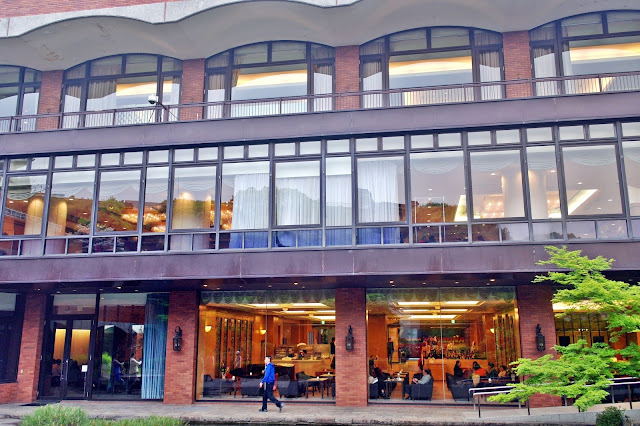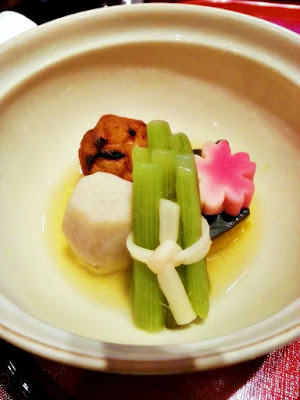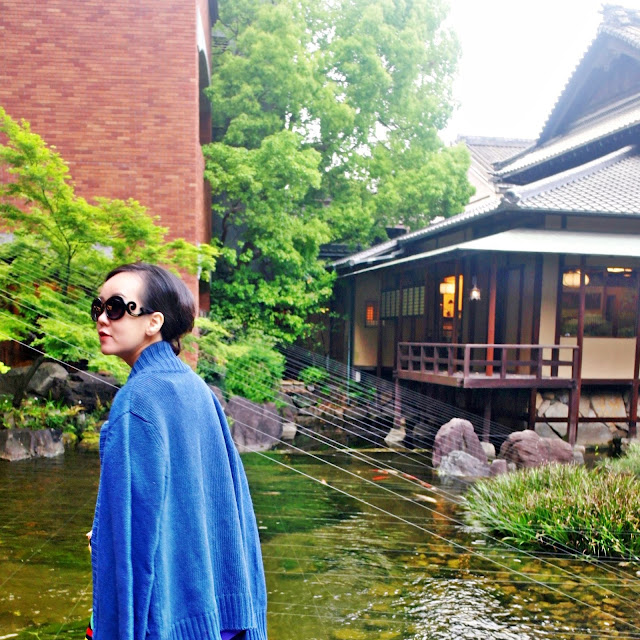We proceed to Osaka by coach after left Kiyomizu Temple...

I dozed all the way from Kyoto to Osaka,
and created this embarrassing 'bad hair day!'
We're going to have traditional multi-course Japanese cuisine (Kaiseki Ryori = 懐石料理) for dinner. We're placed us inside few banquet halls on the second floor. I think because of our large group unable to fit inside one of the restaurants.

Taiko-en is Osaka’s premier ceremony venue with
five restaurants and twelve banquet halls.

There's an exhibition hall beside this wall.
I didn't went in as it's guarded outside.

Taiko-en has a rich and vibrant history as a place for royals.


Splendid 5.7-acre land was once the home of business tycoon,
Baron Denzaburo Fujita (the founder of Fujita Kanko).

He acquired the land on the bank of Yodogawa River, and...

he started to
construct his majestic and impressive mansion in 1890.
It's called Amijima
Palace by locals.

After World War II, Fujita Kanko decided to open the Fujita estate for
business.

He called it “Taiko-en,” named after Toyotomi Hideyoshi who built
the Osaka Castle.
Toyotomi was a
preeminent warrior, general and ruler in 16th century Japan.
He was widely known as “Taiko.”

The property features artificial pond and hill (Tsukiyama-shiki kaiyu-style garden).
 The garden also use unusual and precious rocks
The garden also use unusual and precious rocks
collected from Sho-do island and Mount Ikoma,

Found this stone Torii decorated with straw rope (Shimenawa)
and white zigzag paper strips (Shide) to mark sacred trees or
stones inside this Japanese garden.
 Ok, let me be your guide while waiting for other coaches...
Ok, let me be your guide while waiting for other coaches...
Let's stroll along the pond and beautiful garden full of flowers.
It's nice to enjoy the fresh air and smells of springtime! ^^
It's nice to enjoy the fresh air and smells of springtime! ^^
What is that white building located at end of the garden?
Graceful Western-style Garden Chapel blends well
with the best of Japanese garden.
Vent Vert Garden Chapel.

Ground floor of Geihinkan brick building is a reception hall.
with 'Luxele' French cuisine Restaurant and Cafe 'Brillervert'.

There are banquet and conference halls on 2nd - 3rd floors.
Wedding facilities is on top of the building.

Inside this Japanese-style architecture is
Yodogawatei Japanese Restaurant.

Must be very nice dining inside while gazing at wonderful garden
and koi fish pond outside the restaurant.
 Seasonal Sashimi (Mukozuke / 向付)
Seasonal Sashimi (Mukozuke / 向付)

Ground floor of Geihinkan brick building is a reception hall.
with 'Luxele' French cuisine Restaurant and Cafe 'Brillervert'.

There are banquet and conference halls on 2nd - 3rd floors.
Wedding facilities is on top of the building.

Inside this Japanese-style architecture is
Yodogawatei Japanese Restaurant.

Must be very nice dining inside while gazing at wonderful garden
and koi fish pond outside the restaurant.
For lunch, we had Yudofu (simmered Tofu in hot water) which was known as Shojin Ryori in Kyoto. And Kaiseki Japanese Course for dinner.
Kaiseki Ryori (会席料理) is a traditional multi-course Japanese dinner. Refined Kaiseki set menu of select food served on an individual tray which were meticulous prepared and emphasis on subtle local flavors and seasonal ingredients.
Kaiseki Ryori (会席料理) is a traditional multi-course Japanese dinner. Refined Kaiseki set menu of select food served on an individual tray which were meticulous prepared and emphasis on subtle local flavors and seasonal ingredients.
 Seasonal Sashimi (Mukozuke / 向付)
Seasonal Sashimi (Mukozuke / 向付) 
Grill Fish (Yakimono / 焼物).


Grated yam, pumpkin, vegetables (Shiizakana / 強肴).
Chawan Mushi (Mushimono/ 蒸し物).
Rice with anchovies and miso soup (Tomewan / 止椀)
Only after eating this bowl of rice and miso soup, I felt my tummy filled 80%. Kaiseki is considered a light and delicate meal to be enjoyed slowly and appreciate the different textures, flavors, temperature and presentation of the food.
Our guide told us that all the flowers, leaf or other garnishes are edible, and some is to clean our palate after eating sashimi.
Our guide told us that all the flowers, leaf or other garnishes are edible, and some is to clean our palate after eating sashimi.
Japanese orange sorbet (Mizu-gashi / 水菓子).

Kaiseki meal is the most expensive type of Japanese food.
Normally served in restaurants filled with greenery and beautiful view of Japanese garden.

Add: 〒534-0026 都島区網島町9-10
9-10 Amijima-cho, Miyakojima-ku, Osaka-shi 534-0026
Tel: +81 6-6356-1110












































